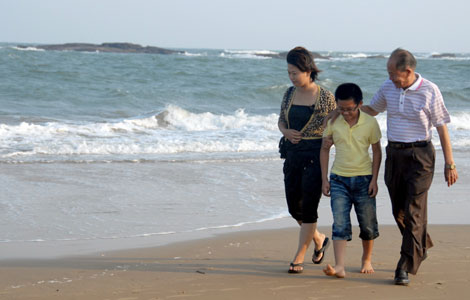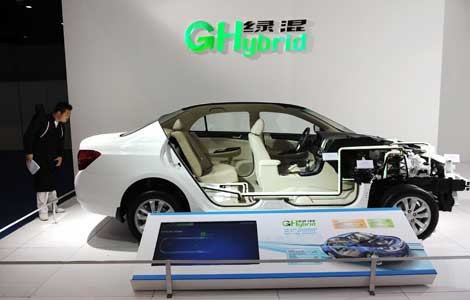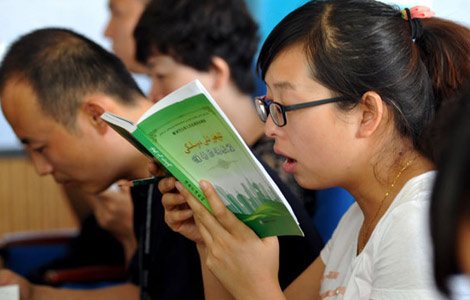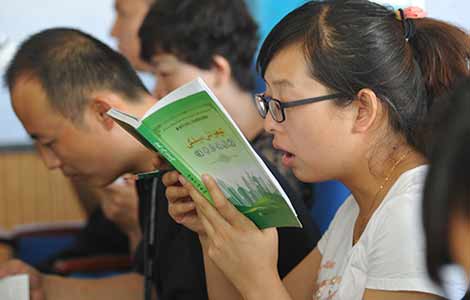Beijing subway standard not realistic, experts say
Updated: 2013-08-10 10:30
By Zheng Xin (China Daily)
|
|||||||||||
A recent attempt made to relieve crowding on subway cars in Beijing is "impractical and unrealistic", according to experts.
Beijing released its first standards and specifications for a local transit project on Thursday, limiting the spatial density on a subway car to five commuters per sq m at most.
The previous standard was six passengers per square meter.
The standard has also specified that transit between subway transfer lines should take no more than 3 minutes.
According to Liu Xiao, a researcher from Anbound Consulting, an independent think tank dedicated to strategic decision research, the standard sounds ideal, but it won't help heavy commuter congestion.
"It's impossible to count how many people are packed in each subway car, let alone per square meter," he said. "The metro staff cannot drive the commuters off the subway either."
Liu said as most people live far from where they work, subway commuting is inevitable.
"Considering the large amount of passengers, it's a challenge to ensure comfort on public transportation," he said.
Benjamin Zifkin, an exchange student in Beijing from the University of Massachusetts Amherst in the United States, said it's impossible to have five people per square meter on the city's subway.
"It sounds cool, but considering the amount of passengers, the standard seems impossible," he said. "Chicago sees much less people on their subways and transferring lines is much easier."
Zifkin added that the subway is usually smelly and sweaty, especially during rush hour.
If the number limit is enforced, hundreds of people would have to wait in large queues for less crowded cars, he said.
According to the Beijing Administration of Quality and Technology Supervision, the standard is in line with international subway design specifications and aims to relieve commuter congestion.
Experts said the solution to crowded subway cars lies in flexible fares.
Zhang Zhuting, a professor at the Ministry of Transport's Management College, said, "The city should come up with a range of fares in accordance with the length of journey and type of carriage, rather than the set price."
Low ticket prices may attract passengers who may not need to take the subway, and exacerbate the problem, he said.
The capital offers the cheapest public transportation nationwide, with the subway fare set at 2 yuan ($0.33) regardless of mileage, and bus fares at 0.40 yuan.
Ridership on the Beijing subway network has been increasing steadily since March, when the city saw a record 10 million passengers a day.
One reason for the boost lies in the increase in available subway lines in recent years.
Beijing plans to further extend the subway to 19 lines with a track length of 561 km by 2015 and reach 1,000 km by the end of 2020.
In 2002, the city had only two lines with a track length of 54 km.
zhengxin@chinadaily.com.cn
Related Stories
Subway crowds get crush warning 2011-09-06 07:16
Beijing subways expecting shorter interval 2013-08-02 14:57
Provincial capital subway ready to roll 2013-08-07 07:18
Shanghai seeks to halt 'subway theater' 2013-07-15 02:27
Subway stations stop human traffic with art pieces 2013-07-10 10:29
Beijing announces 6 new subway lines, sections 2013-05-22 10:27
Today's Top News
3 Chinese citizens killed, 2 missing in Afghanistan
Trade disputes hit solar export prices
New loans, social financing fall again
Industrial growth gaining momentum
Mandela manages to sit up
Arctic trade route opens
Rough road to continue for domestic carmakers
China's inflation rises 2.7% in July
Hot Topics
Lunar probe , China growth forecasts, Emission rules get tougher, China seen through 'colored lens', International board,
Editor's Picks

|

|

|

|

|

|





